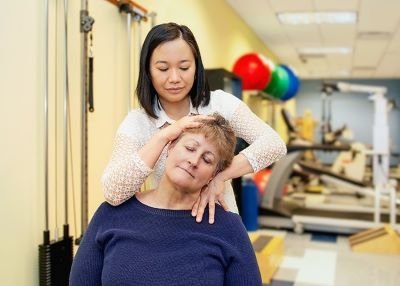A Pain in the Neck
Physical therapy can help with neck pain symptoms and give you control over your pain.

One out of every seven adults will experience neck pain. Neck conditions may cause headaches, pain that extends to the arm and hand, numbness, or a feeling of pins and needles. However, it doesn’t have to limit your activities. By taking charge of the situation, 50% of people with neck pain improve over time, even after whiplash-associated disorders.
Physical therapists can help analyze your situation. They start by asking information as to what positions, activities, or time of day increase or decrease your symptoms, followed by a thorough movement assessment. Once they collect the necessary information, they will develop a plan to help achieve your specific goals.
Your treatment program in the clinic will help to improve joint and/or tissue mobility, enhance control or endurance of muscles, and provide short- and long-term pain management strategies. Your practical home program will include exercise, posture, and activity instructions individualized to your specific needs and lifestyle.
If you are experiencing neck pain, consider scheduling an appointment with a physical therapist to understand why you are experiencing symptoms and to give you control over your pain.
Did you know?
- When standing straight, the head weighs between 8-15 lbs., the same as a bowling ball.
- Slouching increases the weight to 25-30 lbs., or the same as three bowling balls.
- The weight while bending your next to text increases to 50-60 lbs. That’s the same as the entire team’s bowling balls.
- Be sure to sit up straight and stand tall for better neck health.
Jane Borgehammar, PT M.S., OCS, Dip. MDT, FAAOMPT
Sources:
- Assessment of stresses in the cervical spine caused by posture and position of the head
- Course and prognostic factors for neck pain in whiplash-associated disorders (WAD)
- Does it matter which exercise? A randomized control trial of exercise for low back pain
- Recovery Pathways and Prognosis After Whiplash Injury (PDF)
- Use of Complementary Health Approaches for Musculoskeletal Pain Disorders Among Adults (PDF)



